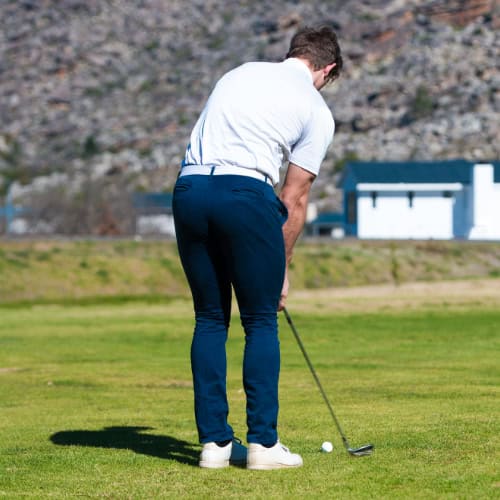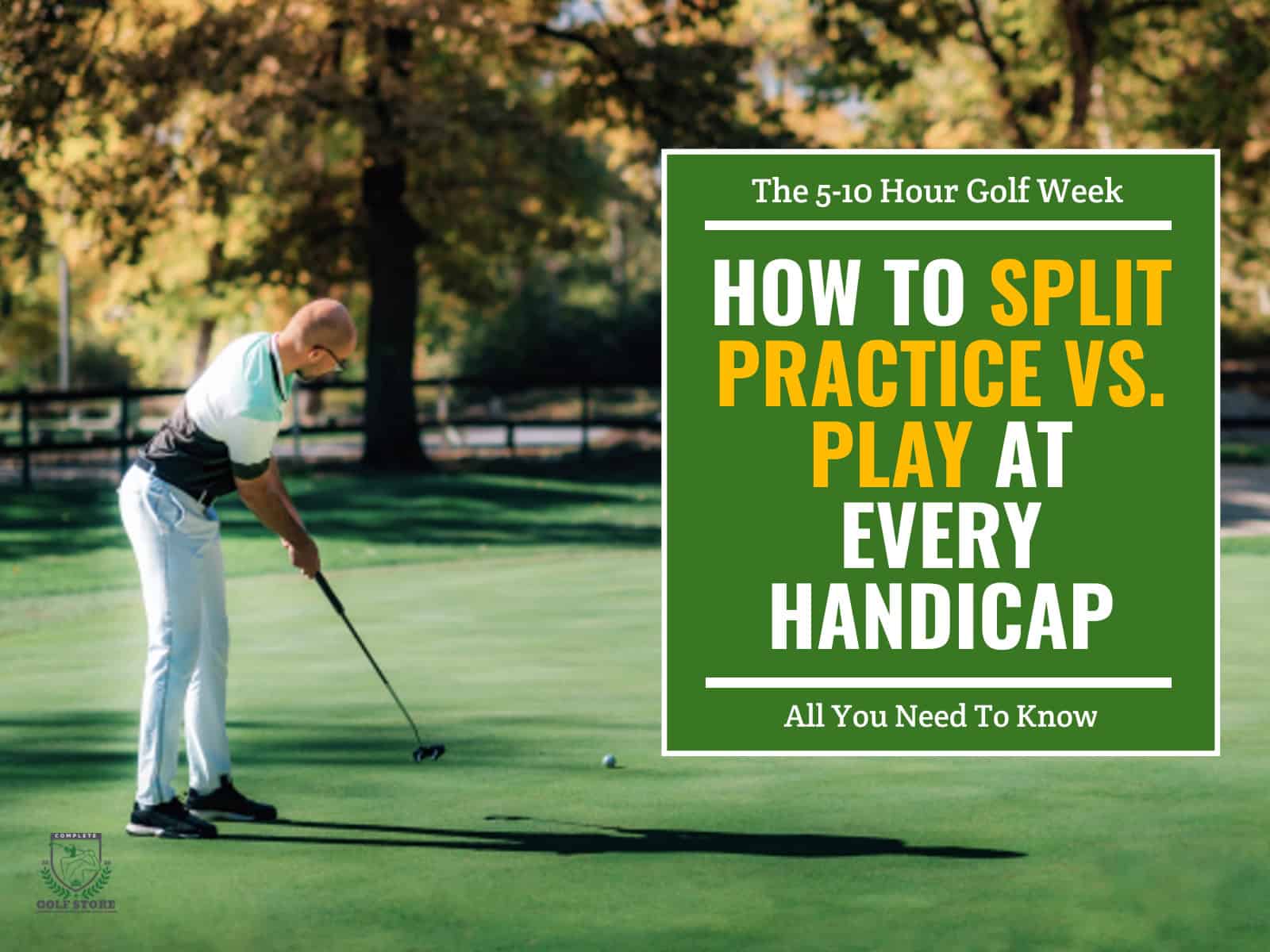Fat golf shots are a common frustration for many golfers, often resulting in a poor shot with minimal distance and a large divot. Understanding the causes and corrections for fat shots can significantly improve your game.
Fat shots can ruin your game and lead to inconsistent play. Regardless of your skill level, avoiding them is crucial for enhancing your performance and enjoyment on the course.
In this guide, we’ll explore what fat golf shots are, their causes and provide actionable tips to eliminate them from your game. By the end, you’ll have the knowledge and tools needed to strike the ball cleanly and confidently every time.
- 1) What Are Fat Golf Shots?
- 2) Causes of Fat Golf Shots
- 3) How to Fix Fat Golf Shots?
- 4) Other Tips to Prevent Fat Golf Shots
-
5)
Frequently Asked Questions
- 5.1) Can changing my grip help with fat shots?
- 5.2) How long does it take to correct fat shots?
- 5.3) Are there specific clubs that cause more fat shots?
- 5.4) Can poor flexibility contribute to fat shots?
- 5.5) How does course condition affect fat shots?
- 5.6) Is there a mental aspect to avoiding fat shots?
- 6) Final Thoughts
What Are Fat Golf Shots?
Fat golf shots, commonly referred to as “chunked” or “duffed” shots, occur when the club makes contact with the ground before the ball. This miscalculation leads to a large divot and a shot that falls short of the intended distance. Essentially, the clubhead digs into the turf, causing a significant loss of energy transfer to the ball.

Visual Description of the Impact
When a fat shot happens, you’ll notice the following:
- Large Divot: The turf is often gouged out, leaving a noticeable scar on the fairway or rough. The divot starts before the ball and is often deeper than usual.
- Ball Flight & Trajectory: The ball may pop up weakly or roll only a short distance, far from the intended target. Low and short flight paths are typical, with the ball losing significant distance.
- Impact Sound: The sound is usually a dull thud rather than the crisp click of a well-struck shot. The impact also feels heavy.
Understanding these fundamentals will help you pinpoint the exact issues in your swing and make the necessary adjustments to avoid hitting fat shots in the future.
Causes of Fat Golf Shots
The following are some common causes of fat shots:
Improper Fundamentals in the Golf Swing
Mastering the basics of the swing is essential to avoid fat shots. Common fundamental errors include poor grip, incorrect stance and flawed swing mechanics.
Each of these elements must work harmoniously to achieve a clean strike. A weak grip or misaligned stance can throw off your swing path, causing the club to hit the ground before the ball.
Check Also: How to Hold a Golf Club Correctly
Steep Swing Plane
A steep swing plane is a major culprit behind fat shots. This occurs when your shoulders tilt excessively instead of rotating naturally. This steep angle forces the club down too sharply, making early contact with the ground inevitable.
To combat this, focus on maintaining a flatter shoulder turn, which encourages a more level swing path and cleaner ball contact.
Weight Distribution
Proper weight transfer is critical in executing a successful swing. Many golfers leave too much weight on their back foot during the swing, resulting in a fat shot.
At the point of impact, ideally, 80 percent of your weight should be on your front foot. This forward shift helps ensure the club strikes the ball before the ground, providing better contact and distance.
Ball Position
Incorrect ball position is another common reason for fat shots. If the ball is too far forward or back in your stance, it can disrupt your swing’s timing and contact point.
The ball should be positioned relative to your stance and club selection—slightly forward for longer clubs and more centered for shorter irons.
Ensuring the ball is in the correct spot can drastically reduce the likelihood of hitting fat shots.
How to Fix Fat Golf Shots?
To fix fat shots, we suggest following these proven tips, tested by our own team:
Maintaining Proper Posture

Proper posture is the cornerstone of a consistent golf swing. You need to stand tall with your feet shoulder-width apart. Your spine should be straight, and your shoulders relaxed.
Lean forward from your hips, not your waist, keeping your back straight. This promotes a more natural swing. Also, maintain a slight bend in your knees to stay balanced and agile.
Correct Weight Transfer
Effective weight transfer is crucial for powerful and accurate shots. At address, distribute your weight evenly between both feet.
During the backswing, smoothly transfer your weight to your back foot while maintaining balance. As you begin the downswing, shift your weight to your front foot, aiming to have about 80% of your weight on your front foot at impact.
Adjusting the Swing Plane
A correct swing plane is essential to avoid fat shots. Instead of a steep up-and-down motion, focus on a more rounded shoulder turn. Ensure your club travels on a shallow path, reducing the likelihood of striking the ground before the ball.
Ball Position Adjustments
For long irons and woods, Place the ball slightly forward in your stance, just inside your left heel (for right-handed golfers).
When hitting short irons and wedges, Position the ball in the center of your stance to promote a steeper angle of attack.
Practice Drills for Consistency
You can also adopt these three simple drills to help fight fat shots:
- Alignment Sticks Drill: Place alignment sticks on the ground to ensure proper ball position and swing path.
- Impact Tape Drill: Use impact tape on your clubface to see where you’re making contact with the ball and adjust accordingly.
- Swing Path Drill: Practice with a towel or headcover placed just outside your ball to encourage a proper swing path.
- Divot Awareness Drill: Place a tee or a line on the ground where the ball would be. Practice swings, ensuring the club contacts the ground after the tee or line. Monitor the divot to confirm it starts at or beyond the ball’s position.
Consistent practice using these techniques will help you eliminate fat shots from your game, leading to more solid contact and improved performance on the course.
Other Tips to Prevent Fat Golf Shots

You may also adopt a few more fixes to get rid of fat shots.
Professional Advice
Incorporating insights from professional golfers and coaches can also enhance your practice sessions:
- Focus on Rhythm: Maintaining a consistent rhythm throughout your swing can help avoid fat shots. Professionals often emphasize the importance of a smooth, tempo-driven swing rather than a rushed one.
- Use Video Analysis: Recording your swing and comparing it with professional swings can help identify issues. Pay attention to your posture, weight transfer and swing plane.
Recommended Resources for Further Learning
To deepen your understanding and skill, consider these additional resources:
Books
- Ben Hogan’s Five Lessons: The Modern Fundamentals of Golf by Ben Hogan
- The Impact Zone: Mastering Golf’s Moment of Truth by Bobby Clampett
Apps
- Golfshot – Provides detailed swing analysis and tips.
- V1 Golf – Allows you to record and review your swing with professional feedback.
You May Also Like: Top 10 must-have golf apps for your iPhone
Frequently Asked Questions
Let’s now answer some commonly asked questions related to fat shots in golf to ensure that you understand all the aspects of the topic at hand.
Can changing my grip help with fat shots?
Yes, adjusting your grip can help mitigate fat shots. Here’s how:
– Proper Grip Pressure: Ensure you’re not gripping the club too tightly. A relaxed grip allows for better swing mechanics.
– Neutral Grip: A neutral grip helps maintain control and prevents the clubface from closing or opening excessively during the swing.
– Grip Position: Your grip should be consistent and correctly aligned with the clubface to promote clean contact.
How long does it take to correct fat shots?
The timeline for correcting fat shots varies depending on several factors, including practice frequency and dedication to improvement. Generally, with focused practice and proper guidance, noticeable improvements can be seen within a few weeks to a few months.
Regular practice and drills tailored to addressing fat shots will accelerate progress.
Are there specific clubs that cause more fat shots?
While fat shots can occur with any club, they are more common with:
Short Irons and Wedges – These clubs are used for precise, shorter shots, which require accurate ball contact. Missteps in technique can lead to fat shots.
Long Irons: These clubs have less loft and require a different swing plane, making them prone to fat shots if not struck correctly.
Using the right club for the shot and ensuring proper technique can help reduce the frequency of fat shots across all clubs.
Can poor flexibility contribute to fat shots?
Yes, poor flexibility can limit your ability to make a full, fluid swing. This restriction can cause compensations in your swing path, leading to fat shots. Regular stretching and flexibility exercises can help improve your range of motion and swing consistency.
How does course condition affect fat shots?
Course conditions, such as wet or soft turf, can increase the likelihood of fat shots. The club can dig into the ground more easily, causing fat contact.
Being aware of course conditions and adjusting your swing accordingly can help mitigate this issue.
Is there a mental aspect to avoiding fat shots?
Absolutely. Fat shots can often stem from a lack of confidence or overthinking your swing mechanics. Staying relaxed and focused, trusting your practice and maintaining a positive mindset can significantly reduce the chances of hitting fat shots.
Final Thoughts
Mastering the art of avoiding fat golf shots can transform your game, bringing newfound confidence and precision to your play. By working on the fundamentals—proper posture, weight distribution, swing plane, and ball position—you pave the way for cleaner, more consistent strikes.
While focusing on avoiding fat shots is crucial, it’s equally important to master specific club techniques. For instance, learning how to hit a pitching wedge correctly can greatly improve your short game and overall scoring.
For golfers looking to refine their short game and eliminate fat shots around the green, mastering the flop shot is a valuable skill. Learn the perfect technique for executing a successful flop shot with our comprehensive guide.
Embrace consistent practice and targeted drills, and don’t hesitate to seek professional guidance. The journey to a better golf game is rewarding, and the improvements you’ll see will make every round more enjoyable.
Thanks for reading!





